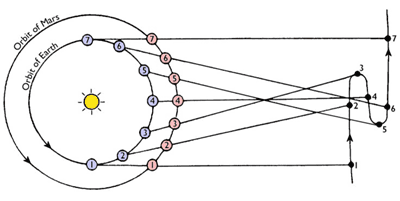This was a revolutionary idea. For more than 1500 years, the geocentric model was accepted as fact, and the Catholic Church refused to budge, even calling the heliocentric model heresy. Ironically, Copernicus was a canon of the Catholic Church who had vowed to stay celibate. His work, the Commentariolus, was a short 40 page essay outlining his ideas.
- Celestial bodies do not all revolve around a single point, i.e. the Moon orbits around one point, the Earth and the planets around another point
- The Moon orbits around the Center of Earth
- The Earth and planets orbit around the Center of the Sun
- Parallax to stars cannot be observed because the Earth-Sun Distance is so much smaller than the distance to the stars. In reality, parallax is so small that they couldn't be measured until almost 400 years later.
- The stars don't move. The motion we see in the stars is due to Earth's motion.
- Earth moves around the Sun, which causes the apparent annual motion of the Sun. Earth rotation causes the apparent motion of the Sun in the sky over the course of a day.
- Earth's orbital motion around the Sun causes the retrograde motion we see in the planets, i.e. why the planets seem to reverse direction and move east to west in the sky relative to the stars rather than west to east.
It wasn't until Johannes Kepler came along that a more modern heliocentric model arrived. Johannes Kepler was an apprentice of Tycho Brahe, who was a strange fellow and may be featured in a later post, and was able to use the thorough and accurate observations made by Brahe to come up with his three laws of planetary motion.
- Planets have elliptical orbits, i.e. circular or oval and the Sun is at one focus.

Hankwang - A line connection the Earth and the Sun will sweep out equal areas in equal times. This was discussed earlier here.

- The cube of a planet's semi-major axis distance equals the square of the planet's orbital period, as long as they are measured relative to Earth. The distance is measured in astronomical units, AU, which is the average distance from the Earth to the Sun. The period is measured in Earth year's. This was actually proved by Isaac Newton with calculus and physics.
How do we use this to explain retrograde motion of the planets?

As the Earth overtakes Mars because it is moving faster, Mars "appears" to be moving backwards. As explained here, it is like a faster car overtaking a slower car on the highway. The slower car appears to be moving backwards with respect to someone in the faster car.
I think this post might raise some questions, and if you do, please leave a comment. I will try to explain them in a future post.


No comments:
Post a Comment